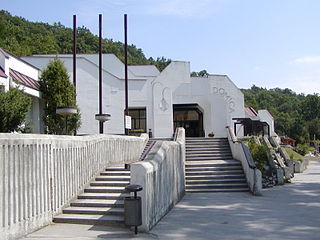Domica
| Domica
|
||
|---|---|---|
|
Entry area |
||
| Location: | Community Kečovo at Plešivec | |
| Height : | 339 m nm | |
|
Geographic location: |
48 ° 28 ′ 36 " N , 20 ° 28 ′ 21" E | |
|
|
||
| Geology: | Wetterstein lime | |
| Type: | Stalactite cave | |
| Discovery: | 1926 | |
| Show cave since: | 1932 | |
| Lighting: | electric | |
| Overall length: | 5368 m | |
| Level difference: | 12 m | |
| Length of the show cave area: |
1315 m | |
| Particularities: | Guided tour with boat trip possible | |
| Website: | http://www.ssj.sk/jaskyne/spristupnene/domica/ | |
The Domica Cave ( Jaskyňa Domica ) is a stalactite cave in Slovakia near the Hungarian border in the Slovak Karst . Thanks to its beautiful stalactites, it is considered one of the most beautiful caves in Slovakia.
description
The cave is located in the area of the Kečovo municipality near Plešivec , on the southwestern edge of the Silická planina ( Silica Plateau ). It is located in the Domické škrapy nature reserve in the Slovak Karst National Park . It forms a common system with the Aggtelek cave (Hungarian Baradla ) in Hungary (a total of 21-25 km).
history
Various finds from the Paleolithic and Neolithic Age have been made in the cave . The Neolithic finds belong to the Bükk culture , a part of the linear ceramic band . The excavations were carried out by the archaeologist Jan Lichardus . A couple of charcoal drawings have been preserved in the rear of the cave.
The Aggtelek cave was mentioned as early as 1770. The Domica cave had been known since around 1808, but was forgotten due to the heavily visited Aggtelek cave. It was not until the demarcation between Czechoslovakia (now Slovakia) and Hungary after the First World War that Ján Majko, a member of the financial guard, came back in 1926. In 1932 the cave was opened to the public and in 1972 it was declared a protected natural formation. At the time, a grille was installed at the site of the Slovak-Hungarian border. Radim Kettner , who founded the associated museum, was in charge of geoscientific research .
Characteristic
With a total length of 5080 m, 1315 m are accessible.
Guided tours take place all year round. The extraordinary beauty of the cave can also be admired on a boat trip. Domica is known for its spacious dome and in one of them the famous Slovak fairy tale " The Salt Prince " (original title: Soľ nad zlato ) was filmed.
Domica was created by periodic underground currents from the Styx and Domica streams . The Styx forms a small lake in the Domica. Years of erosive activity in these brooks have widened fractures, creating the wide corridors and halls. The domica is characterized by rich sinter decoration . Signs and drums, onion-shaped stalactites , pagoda-shaped stalagmites and sinter basins are unique .
The cave has several rooms, halls and corridors and all of them have their own names, such as Cathedral of the Mysteries , Pottery , Jungfrauenpassage , Glückssee , Primeval Forest , Cathedral of the Indian Pagodas and others. Majkos Dom is the largest hall in the cave. It is the meeting point of all corridors and is beautifully decorated. The underground river Styx flows through cascading waterfalls, which are also called the Roman Bath .
One of the special features is the abundant population of bats . There are 16 species of bat in the cave system.



